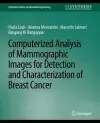
Computerized Analysis of Mammographic Images for Detection and Characterization of Breast Cancer
4 authors - Paperback
£44.99
Paola Casti graduated with honors in Medical Engineering in 2011 from the University of Rome Tor Vergata, with a thesis titled ""Development and validation of a computer-aided detection system for the identification of bilateral asymmetry in mammographic images."" In 2015,she received a Ph.D. in Telecommunications and Microelectronics Engineering with the mention of Excellent Quality Cum Laude. The title of her dissertation was ""Development of an innovative system for early detection and characterization of breast cancer."" During her engineering studies, she was a four-time winner of the annual student award of excellence (given to the top 1% of engineering students) from the University of Rome Tor Vergata. In 2009, she was awarded 1st place in a student competition for the mechanical analysis and computer-aided design of a patented prosthesis, with a project titled ""Multi-configurable Wrist Joint Prosthesis."" She collaborated with the National Institute of Health (Istituto Superiore di Sanita, ISS) in 2009 on a project for microtomographic evaluation of bone substitutes and the obtained results have been published in the Rapporti ISTISAN of the ISS. In 2012, she was selected as one of the young researcher participants of the IEEE EMBS International Summer School on Biomedical Imaging, held in Ile de Berder, Brittany, France. She has coauthored several papers in international peer-reviewed journals, a number of papers in proceedings of international conferences, and technical reports. Her research interests are in signal and image analysis for medical applications, pattern recognition and classification, and computer-aided diagnosis. At present, she is working with the Department of Electronics Engineering of the University of Rome Tor Vergata with a research contract.Arianna Mencattini received an M.S. degree in Electronic Engineering from the University of Rome Tor Vergata, Rome, Italy in 2000, summa cum laude, and a Ph.D. in 2004 for her research on fuzzy logic systems for modelling from the same University. In 2001, she received the award of a Young Researchers Grant and in 2004-2005 she had a scholarship from the Sixth Framework Programme of the European Community at the University of Rome Tor Vergata. Since 2006 she has been an Assistant Professor at the Department of Electronic Engineering, University of Rome Tor Vergata. She is member of the Italian Electrical and Electronic Measurement Group. At present, she teaches a course on image processing. Her main research interests are related to image processing techniques for the development of computed-assisted diagnosis systems, analysis of speech and facial expressions for automatic emotion recognition, and design of novel cell tracking algorithms for immune-cancer interaction analysis. She is the Principal Investigator of the project ""PainTCare, Personal pAIn assessemeNT by an enhanCed multimodAl architecture,"" funded by the University of Rome Tor Vergata, for the automatic assessment of pain in postsurgical patients, and team member of the Project Horizon 2020 ""PhasmaFOOD: Portable photonic miniaturised smart system for on-the-spot food quality sensing."" She has coauthored more than 70 papers in international journals and conferences.Marcello Salmeri received a M.Sc. degree in Electronic Engineering and a Ph.D. in Electronic Engineering from the University of Rome Tor Vergata, in 1989 and 1993, respectively. He is currently an Associate Professor with the Department of Electronic Engineering, University of Rome Tor Vergata, and Coordinator of the Electronic Engineering courses. His research interests include signal and image processing; theory, applications, and implementations of fuzzy systems; and pattern recognition. He is the author of about 100 publications in the fields of electronics, measurement, and data analisys.Rangaraj Mandayam Rangayyan is Professor Emeritus of Electrical and Computer Engineering at the University of Calgary, Calgary, Alberta, Canada. He received a Bachelor of Engineering degree in Electronics and Communication Engineering in 1976 from the University of Mysore at the People's Education Society College of Engineering, Mandya, Karnataka, India, and a Ph.D. in Electrical Engineering from the Indian Institute of Science, Bangalore, Karnataka, India, in 1980. He served the University of Manitoba, Winnipeg, Manitoba, Canada and the University of Calgary in research, academic, and administrative positions from 1981-2016. His research interests are in digital signal and image processing, biomedical signal and image analysis, and computer-aided diagnosis. Dr. Rangayyan has published more than 160 papers in journals and 270 papers in proceedings of conferences. He has supervised or cosupervised 27 Master's theses, 17 Doctoral theses, and more than 50 researchers at various levels. He has been recognized with the 1997 and 2001 Research Excellence Awards of the Department of Electrical and Computer Engineering, the 1997 Research Award of the Faculty of Engineering, by appointment as ""University Professor"" (2003-2013) at the University of Calgary, and with an Outstanding Teaching Performance Award of the Schulich School of Engineering (2016). He is the author of two textbooks: Biomedical Signal Analysis (IEEE/ Wiley, 2002, 2015) and Biomedical Image Analysis (CRC, 2005). He has coauthored and coedited several other books, including Color Image Processing with Biomedical Applications (SPIE, 2011). He has been recognized with the 2013 IEEE Canada Outstanding Engineer Medal, the IEEE Third Millennium Medal (2000), and elected as Fellow, IEEE (2001); Fellow, Engineering Institute of Canada (2002); Fellow, American Institute for Medical and Biological Engineering (2003); Fellow, SPIE (2003); Fellow, Society for Imaging Informatics in Medicine (2007); Fellow, Canadian Medical and Biological Engineering Society (2007); Fellow, Canadian Academy of Engineering (2009); and Fellow, Royal Society of Canada (2016).